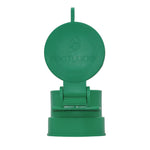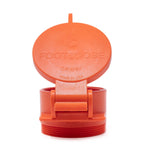You have no items in your shopping cart.
Made of durable materials, manhole covers are crafted to endure the harshest of environments. However, several considerations must be made before placing or removing a manhole cover, which makes the type of equipment used a crucial part of the job.
Before you install or remove a manhole cover, you should have the right tools and equipment ready to make the job safer and easier for you and others around you. In this article, we will summarize the types of manhole covers and equipment that are necessary to use before and after installation.
The Purpose of Manhole Covers and Equipment
Manhole covers are typically created for the purpose of securing the entrance of drainage systems and utility vaults. When they are removed, authorized professionals can enter manholes to perform necessary maintenance, repairs, and routine inspections.
The average manhole cover is found on busy city streets, which allows vehicles to drive over manholes with ease. They may also be found in areas frequented by pedestrians as a safety precaution for those walking by, specially engineered to only allow professionals to gain access.
Manhole covers are most easily maintained, installed, and removed by using the proper equipment. This equipment helps to prevent injury while working in or around manholes, making the workplace a safer experience for everyone. The type of equipment varies according to usage, features, and requirements, which is important for prospecting manhole cover buyers to consider.
What Shape Do Manhole Covers Take?
Contrary to what one may think, manhole covers aren’t always created equally in terms of physical appearance. Manhole covers most commonly take the form of two distinct shapes: round and circular or square and rectangular. But what exactly determines the shape that a manhole cover will take in any given area?
Round
Round manhole covers are most commonly seen in public locations, such as city streets or neighborhood walkways. The reason these manhole covers are made round is to equip them with maximum strength and durability. This increased strength comes from the way the manhole cover holds against the compression of the earth surrounding it.
Square
Although round manhole covers are considered to be the strongest, square manhole covers are created for convenience where underground structures meet up with an intersection of pipes. The straight, flat sides of a square or rectangular manhole cover, therefore, allow workers and machinery to access the underground sewer line more efficiently.
What Are Manhole Covers Made Of?
Manhole covers are made from various different materials, each created for optimal use in a certain environment. A manhole cover being placed in an area with heavy traffic would require a powerful and robust material, while a manhole cover for pedestrian use would allow more lightweight material. These types of materials include:
- Cast Iron – Manhole covers made from cast iron are strong and durable, capable of holding up to 90 tonnes, and usually placed over deeper shafts.
- Steel – Created for lighter loads, steel manhole covers are typically placed in domestic driveways and walkways.
- Composite – Capable of being placed in harsh environments, composite manhole covers are made from advanced fiberglass reinforced plastic materials that make them non-corrosive and non-conductive.

Types of Manhole Cover Equipment
Once your manhole cover is installed, investing in proper, quality equipment is essential to perform maintenance on your manhole and access it safely. From cleaning accessories to heavy-duty tools that ease physical labor, the right manhole cover equipment can make a tough job much easier and safer.
Manhole Cover Lifters
Manhole cover lifters, otherwise known as manhole hooks or keys, are used to install and remove a manhole cover safely to prevent injury. The manhole key is hooked onto a manhole cover to be lifted and pried open by an authorized professional. These lifters come in a variety of shapes and sizes that optimize use for the individual worker and can be found with features like a rotated handle, handle wrench, and a flat handle.
Locking Caps
The locking cap can be secured onto a PVC well pipe to create a tamper-proof compression seal that's only accessible by the keyholder. Locking caps are commonly made of durable plastic or ductile iron that is UV protective and watertight.
Parachutes
Typically ranging from 4” to 36” and made from nylon, parachutes are used along with a fan or vacuum to run string through wet or dry sewer lines. A quality parachute will string through 300” of sewer line in under a minute without plugging the line.
Pressure Gauge
A gas gauge allows professionals to easily monitor the pressure inside of a manhole safely and effectively. These gauges are typically available in a PSI pressure range of 0 to 100.
Frequently Asked Questions
What are monitoring well manholes?
If you need access to a sewer to monitor or obtain samples, a monitoring well manhole will get you there. These types of manholes are manufactured to be installed on top of a monitoring well to help people get underground for inspections safely and efficiently.
Is it illegal to access a manhole?
Since manholes usually lead to public sewer systems, manholes are typically only accessed by workers that have been authorized to enter under the permission of city officials. The only reasons a manhole will be accessed is to conduct necessary repairs, maintenance, cleaning, or routine inspections.
How deep are manholes?
The depth of a manhole ranges across three different types: shallow, normal, and deep. A shallow manhole is anywhere from two to three feet deep, while a normal manhole can be from three to five feet deep, and a deep manhole is typically deeper than five feet.
How much do manhole covers weigh?
The standard manhole cover weighs more than 250 pounds. The heavy weight of a manhole cover plays a key role in its ability to remain in the correct position as busy traffic drives over it, preventing the manhole cover from becoming dislodged. However, the manhole cover should be at a reasonable enough weight that allows it to be lifted with a manhole hook by professionals but doesn’t allow unauthorized people to pick it up themselves.
What are safe working practices around manholes?
Before working in or around manholes, it is important to go into it with the necessary training and awareness. Lifting something as heavy as a manhole cover can severely injure your back if not done properly, which means it is crucial to practice safe lifting techniques, such as straightening your back, bending your knees slightly, and using your legs to push down and lift the cover with a manhole hook. Wearing heavy-duty gloves should also be advised to prevent injuring your hand on the manhole cover’s sharp or rough surface.
Are You Missing Any Manhole Cover Equipment?
Despite their obscurity in everyday conversation, manhole covers are intricate creations manufactured according to their prospected location or usage. Several factors go into their installation and removal, meaning that using the proper equipment is crucial.
The type of equipment you need will vary according to your specific manhole cover and where it will be installed. At Enviro Design Products, we offer a wide variety of manhole covers, lids, and equipment that are suitable for nearly all types of residential and commercial projects. Visit our shop to choose from a selection of top-quality accessories to keep your manholes secure, watertight, and tamper-free.










